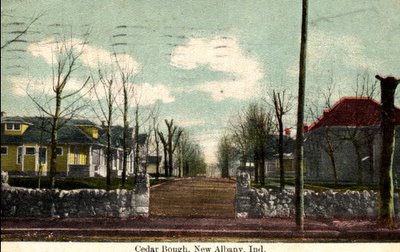 The following is taken from the "Historic District Design Guidelines City of New Albany". The Guidelines not only provide homeowners direction on exterior work to their property, but also include short histories of each of our four local historic districts.
The following is taken from the "Historic District Design Guidelines City of New Albany". The Guidelines not only provide homeowners direction on exterior work to their property, but also include short histories of each of our four local historic districts.
 Cedar Bough Place, aka "the Bough", is where I live. Simply walk or drive straight up 13th Street and cross over Ekin and you will be on the Bough.
Cedar Bough Place, aka "the Bough", is where I live. Simply walk or drive straight up 13th Street and cross over Ekin and you will be on the Bough.
___________________________________
The Cedar Bough Place Historic District consists of the houses on Cedar Bough Place, a short private street that runs between Ekin Avenue and Beeler Street. It is one of only a handful of private streets remaining in the city of New Albany.
When Lot 42 of the Illinois Land Grant was divided, Cedar Bough Place was laid off into lots, roads, etc. and sold on the 17th day of September, 1836 by Margaret Loughrey with the following provision: “and I hereby certify all roads, alleys, streets, etc., laid off of said ground to be for the common benefit of the purchasers and owners of said lots.” The streets and alley were not to be opened to the public without the consent of the majority of the property owners.

The land remained undeveloped until the late 19th century, probably held for speculative purposes. When development began the quality of house construction caused Cedar Bough Place to be considered one of New Albany’s most prestigious addresses. The phrase “living on the Bough” was often heard in New Albany when describing a person or family who had a Cedar Bough Place address.


The neighborhood’s condensed period of development, the short length of the street, and the similar size and scale of homes all contribute to the character of Cedar Bough Place.
Only one lot on the street is vacant, and there have been no modern intrusions. The majority of the homes are very well maintained and in a good state of preservation.

The houses in the district, built between 1890 and 1910, are mostly Queen Anne style homes, as well as cross-plan and composite cottages with Queen Anne detailing. The c.1890 house at 831 Cedar Bough Place is the most elaborate example of the Queen Anne style.

Notable examples of composite cottages are located at 811, 833 and 838 Cedar Bough Place.
Slightly later styles represented in the district include American Foursquare (821 Cedar Bough Place), Bungalow (836 Cedar Bough Place) and Craftsman (837 Cedar Bough Place).

Notable Cedar Bough Place residents have included: Ferdinand Kahler, founder and president of Kahler Furniture Manufacturing Company (837 Cedar Bough Place); local restaurateur Tommy Lancaster (839 Cedar Bough Place); and F. Shirley Wilcox (837 Cedar Bough Place) who was appointed Indiana's chief of Internal Revenue Service collections by President Harry Truman and later was State Treasurer.









 The following is taken from the "Historic District Design Guidelines City of New Albany". The Guidelines not only provide homeowners direction on exterior work to their property, but also include short histories of each of our four local historic districts.
The following is taken from the "Historic District Design Guidelines City of New Albany". The Guidelines not only provide homeowners direction on exterior work to their property, but also include short histories of each of our four local historic districts.







